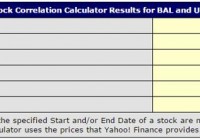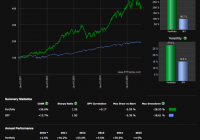Everyone Should Consider These Crisis-Immune Stocks
Summary After six years of rising share prices in the United States, I start to feel a little uncomfortable with current valuations. In this article I try to find out which companies and industries are likely to do well when the going gets tough in financial markets.. I calculated the share returns of American S&P 500 companies and European Stoxx 600 companies and industries during the financial crisis in 2008. I intend to increase the weights of stocks in my portfolio that are active in defensive sectors like consumer staples, health care, utility and energy. Readers can look for their own crash-resistant company in a spreadsheet list that is provided at the end of the article. My dilemma is simple. Professor’s Jeremy Siegel’s plea that stocks are the best asset class to own in the long run is very convincing (please read his brilliant books Stocks in the long run and The Future for Investors ). However, at the current valuations I strongly believe long run future returns will be low single digit at best for the S&P 500 as a whole, see this previous article of me. The simple answer to this dilemma is that I should look for the right stocks. I argued in earlier articles that I like to invest in companies that have their earnings protected by a wide moat such Wal-Mart (NYSE: WMT ), Nestlé ( OTCPK:NSRGY ) and Unilever (NYS: UN ). In my view these companies will be able to generate handsome returns despite above average valuations, because they can invest every dollar they retain out of profits in a very lucrative way. In previous articles, I reasoned that investors should ignore short term price fluctuations if they are convinced the earnings power – that is the possibility to reinvest retained earnings in a lucrative way – has not changed. As long as the sustainable competitive advantage of the company – or what super investor Warren Buffett calls a moat – is unaltered, there is absolutely no reason to sell your shares. This point of view makes perfect sense in theory. In practice when shares plummet day after day and everybody thinks the end of civilization is near, it is extremely difficult to assess the long term earnings power of a company. Therefore, the purpose of this article is to find companies that are great investments and tend to do well when things get tough in financial markets. Forget useless math If have read dozens of (academic) papers and books on the concept of risk. The trouble is that most of the metrics used in finance – think volatility, beta, Value at Risk, etc – are close to useless in the real world because they explicitly or implicitly assume share returns are distributed according to a so called normal distribution (almost all the returns are close to the average). In the real world investors are faced with outliers, or returns that are light years away from the average. Although the academic world tries to construct models that try to deal with outliers, the approach I use to capture risk of individual shares in this article is extremely simple (the way I prefer things to be). I calculated the returns of stocks in particular sectors and individual stocks in the United States and Europe from top to bottom during the credit crisis. To be honest, the saying ‘financial markets have no memory’ seems applicable to me. I was a little shocked by the returns that were spitted out by my Bloomberg terminal doing the analysis. In the credit crisis the S&P 500 and Stoxx 600 – the 600 biggest European companies by market capitalization – lost 55.2 percent and 58.2 percent respectively of their value from top to bottom during this period. Stomach this! Stocks lost more than half of their value during the credit crisis Index Top Bottom Total Return S&P 500 index 10-9-2007 9-3-2009 -55.2% Stoxx 600 1-6-2007 9-3-2009 -58.2% Source: Bloomberg. Nowhere to hide I suspect that most readers are familiar with the story about the statistician who drowned in a lake with an average depth of six inches. Averages can be dangerous as the distribution around the average can be wide. Therefore, I grouped the companies in industry segments to see how each segment reacted during the crisis. I use the Global Industry Classification Standard (GICs, you can find which industry group belongs to which sector on this wiki page). Which American industry did best and worst during the credit crisis? Returns of S&P 500 Companies Returns of Stoxx 600 companies Sector # Mean Rec. return Sector # Mean Rec. return Consumer staples 33 -33,1% 49,4% Energy 23 -32,7% 48,5% Health care 50 -39,1% 64,3% Health care 36 -33,9% 51,4% Utility 29 -40,9% 69,3% Telecom services 19 -35,2% 54,3% Energy 37 -49,2% 96,8% Consumer staples 44 -36,8% 58,3% Materials 26 -50,5% 101,9% Utility 25 -38,8% 63,3% Information technology 62 -51,2% 105,1% Materials 48 -50,3% 101,1% Consumer discretionary 77 -53,6% 115,4% Information technology 27 -52,3% 109,7% S&P 500 -55,2% 123,3% Industrials 111 -54,7% 120,6% Industrials 60 -55,8% 126,0% Stoxx 600 -58,2% 139,0% Telecom services 6 -56,3% 129,0% Consumer discretionary 81 -60,1% 150,7% Financials 86 -68,1% 213,4% Financials 121 -64,6% 182,1% Source: Bloomberg. Return represents total shareholder return, including dividends. # represents the number of companies within each sector. Recovery return is the return necessary to recover your initial investment. Given the nature of the last big crisis I suspect few readers will be surprised by the worst performing sector: financials. Financial companies lost a staggering 68.1 percent in the U.S. and 64.6 percent in Europe of their market value from top to bottom. Note that in some cases the investors had to deal with the worst thing that could happen to a value investor: a permanent loss of capital. For example Lehman Brothers went bankrupt and both Bear Stearns (JP Morgan) and Wachovia (Wells Fargo) were absorbed by other investment banks. It is good news for investors that the top performing sectors are also fairly similar on both sides of the ocean. The sector consumer staples (mainly food, beverages, tobacco and personal products), Health care (equipment, pharmaceuticals and biotech), Utility and Energy are all represented in the top five in both the U.S. and Europe. The average returns of these sectors are all above the average of the market. Do not get me wrong: the performance was still horrible. This was the scary thing of the credit crisis: every share and asset class – even gold! – collapsed due to the a complete loss of faith in the financial system. But – and this is in my opinion very important – even in the credit crisis it still mattered a lot if the value of your portfolio dropped by 33 percent (fully invested in consumer staples), 55 percent (invested in the index) or 68 percent (fully invested in financials). Let’s do the math. If the value of a portfolio drops by 33 percent an investors needs a return of about 50 percent to get back to where he or she started. But if you lost 55 percent or 68 percent of value an investor needs a return of respectively 123 percent (factor 2.5) and 213 percent (factor 4.3!) to recover you initial investment value. You find the ‘recovery returns’ of each individual sector in the table above. As a side note I like to inform you that I also examined the returns of each industry in the aftermath of the burst of the internet bubble in 2000 in both the U.S. and Europe. In that period the same defensive sectors outperformed the market (most of these sectors even realized positive returns as the loss in market capitalizations was concentrated in internet companies). A quest for cheap crash proof stocks After a 6 year period in which markets have treated us well – again leading to expensive stocks – it makes sense to me to increase the weights in my portfolio to stocks that tend to do well in downturns. Therefore, I am looking for stocks that are active in the consumer staples, health care, utility and energy sector. However, although I favor the simple over the complex, there is always the risk of taking too many shortcuts. An investor always runs the risk that stocks that were resilient in 2007 will prove to be horrible investments during the next crash. The thing I do to deal with this problem is to look at valuations. As a value investor, I believe the price you pay determines the return of a financial asset. This implies an investor can pay too much, even for the most defensive stock. My method to find crash proof shares is fairly straightforward. In this spreadsheet you find the names of the shares of the S&P and Stoxx companies, its sector and return during the credit crisis (source: Bloomberg). Moreover, I added the P/E-ratio in 2007 (pre-crisis) and the current P/E of every share. In my quest for resilient stocks I look for shares in defensive sectors that have P/E-ratios that are similar, preferably lower, than before the crisis. In the last step an investor should investigate if there is a reason for the low valuation. The investors should for instance examine if the nature of the business have changed permanently in the past 6 years due to divestitures or acquisitions. Investors should also try to assess whether the markets for its end products have structurally changed due to disruptive entry of new competitors (although I believe one can find value in oil today, some investors believe this could be the case with oil stocks). I additionally cannot stress enough the importance of a strong balance sheet. In the aftermath of the credit crisis, I have seen billions of shareholder value getting destroyed by overleveraged companies that faced a decline in cash flows and had to raise capital at very unattractive terms for existing shareholders to survive. Wal-Mart as an example It is beyond the scope of this article to examine individual stocks in great detail. For now I only want to have a close look at the best performing sector in the U.S. during the credit crisis: consumer staples. The best performing stock in this sector is retail giant Wal-mart. To me it is absolutely amazing this stock gained 7 percent in the worst investment climate ever. In this long read article, I extensively argue that Wal-Mart is an attractive investment at the current valuation. After my analysis of today, I decided to increase my position in the company. I not only expect attractive long run returns of Wal-mart, I also expect the stock will be resilient in an unfortunate scenario where markets start turning against us. Thanks for reading, and I hope you find some great stocks yourself by scrolling down the list — please let me know which. Editor’s Note: This article discusses one or more securities that do not trade on a major U.S. exchange. Please be aware of the risks associated with these stocks. Disclosure: I am/we are long WMT. (More…) I wrote this article myself, and it expresses my own opinions. I am not receiving compensation for it (other than from Seeking Alpha). I have no business relationship with any company whose stock is mentioned in this article.

